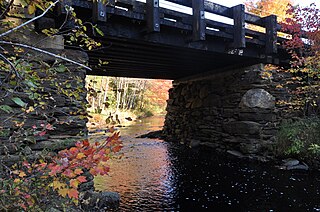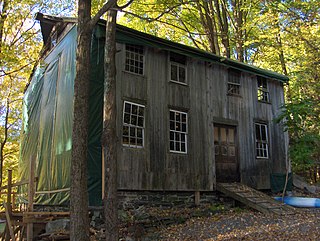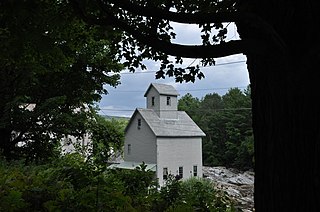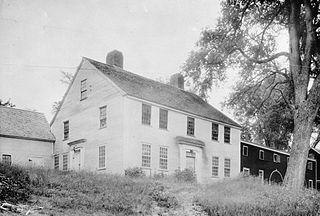
Montauk State Park is a public recreation area occupying nearly 3,000 acres (1,200 ha) at the headwaters of the Current River, fifteen miles (24 km) southwest of Salem, Missouri. The state park contains a fish hatchery and is noted for its rainbow and brown trout angling. It was acquired in 1926. The park has several natural springs including Montauk Spring with a daily average flow of 53 million gallons of water.

The Malvern Roller Mill, also known as Appel Mill and Malvern Milling Company, is a 19th-century grist mill located near the unincorporated village of Malvern, Illinois, in rural Whiteside County, north of Morrison, Illinois, United States. The original mill on the site, built by 1853, was destroyed by a flood and the present mill was erected in 1858. The mill's first owner was William P. Hiddleson who operated the mill until he sold to Benjamin Hough in 1871. The mill changed hands over the years until it landed under the control of George Appel in 1892. The Appel family closed the mill in 1942 but it remained in their family until 1985. The Malvern Roller Mill was added to the U.S. National Register of Historic Places in 1995.

The Tuthilltown Gristmill is located off Albany Post Road in Gardiner, New York, United States. It was built in 1788, as the National Register reports, and has been expanded several times since.

The Gurleyville Historic District encompasses a formerly industrial rural crossroads village in Mansfield, Connecticut. Centered on Gurleyville and Chaffeeville Roads, it includes a collection of mainly vernacular 19th-century residences, a stone gristmill dating to about 1749, and the archaeological remains of later industrial endeavours. The district was listed on the National Register of Historic Places in 1975.

Williston Mill Historic District is a national historic district in Denton, Caroline County, Maryland. It consists of two historic structures—a grist mill and a miller's house—which share the acreage with the mill stream and race that empties into Mill Creek, a tributary of the Choptank River. The Williston miller's house is a two-story, four-bay single-pile frame dwelling, built originally between 1840 and 1850 with later 19th century expansions. The mill building dates from around 1830–1840, with the two-story section built around 1895. It is one of two grist mills that remain standing in Caroline County.

The Garland Mill is a historic sawmill on Garland Road in Lancaster, New Hampshire. Built about 1860, and repeatedly modified to adapt to growth and new technology, it is the only water-powered sawmill in the state. The property was listed on the National Register of Historic Places in 1982.

The Newlin Mill Complex, also referred to as The Newlin Grist Mill, is a water-powered gristmill on the west branch of Chester Creek near Concordville, Pennsylvania built in 1704 by Nathaniel and Mary Newlin and operated commercially until 1941. During its three centuries of operation, the mill has been known as the Lower Mill, the Markham Mill, the Seventeen-O-Four Mill and the Concord Flour Mill. In 1958 the mill property was bought by E. Mortimer Newlin, restored and given to the Nicholas Newlin Foundation to use as a historical park. Water power is still used to grind corn meal which is sold on site. The park includes five historical buildings, which were added to the National Register of Historic Places in 1983, and 150 acres (61 ha) of natural woodland.

The Winthrop Mill is a historic mill building on Mill Street in New London, Connecticut. It is a grist mill located astride Briggs Brook between bridges carrying the eastbound and westbound lanes of Interstate 95. The mill was established in 1650, and the complex retains elements that are believed to be original to its construction. It is now owned by the city and the grounds are open daily; the mill itself is open for tours by special appointment. The property was added to the National Register of Historic Places on November 30, 1982.

The Grist Mill Bridge is a historic bridge in Lebanon, Maine, carrying Little River Road across the Little River. Although the bridge has a 20th-century wooden deck on rubblestone abutments and pier, it is functionally similar to the bridge's original deck, which was also a wooden structure that may have existed as early as 1774. The bridge was listed on the National Register of Historic Places as a rare example of a bridge in the state with some essential 18th-century elements intact.

The Old Grist Mill is a historic mill building on Little River Road in eastern Lebanon, Maine. Built in 1774, it is the town's oldest surviving industrial building, and was in operation as a mill into the 20th century. The building, listed on the National Register of Historic Places in 1975, has been converted into a residence and retail/artist space.

Gillette's Grist Mill is a historic grist mill on Maple Hollow Road in New Hartford, Connecticut. Probably built in the mid-19th century, it is an extremely rare example of a grist mill with a surviving water wheel. The mill property was added to the National Register of Historic Places in 1977.

The Mill at Freedom Falls is a historic mill complex at Mill and Pleasant Streets in Freedom, Maine. The main building, constructed in 1834, is the only mill built at this site, and the only one to survive nearly unaltered in the village. The mill and its surviving dam were listed on the National Register of Historic Places.
The Dexter Grist Mill, now the Dexter Historical Society Museum, is a historic 19th-century industrial property in Dexter, Maine. Built in 1654, the mill was operated by a single family for over a century, and was converted to a museum in 1967. It was listed on the National Register of Historic Places in 1975.

The Clary Mill is a historic mill building and associated water-control structures at 104 Mills Road in Whitefield, Maine. The property includes a late 19th-century wooden mill, a mill pond, dam and penstock. It is the last surviving sawmill in the town, which was once heavily dependent on the lumber industry. It was listed on the National Register of Historic Places in 2004.

The Kingsley Grist Mill Historic District encompasses a well-preserved small late 19th-century mill complex with surviving 18th-century remnants a Gorge and East Roads in Clarendon, Vermont. The complex includes a house, barn, mill and other outbuildings, and the nearby Kingsley Covered Bridge. The district was listed on the National Register of Historic Places in 2007.

The Lermond Mill, now also known as Morgan's Mill, is a historic mill complex on Payson Road in Union, Maine. With a history dating to the late 18th century, and its present buildings from the early 19th century, it is one of the oldest operational water-powered mills in the state of Maine. It was listed on the National Register of Historic Places in 1984. As of 2006, it was reported to be in use for power generation and as a grist mill.

The Head Tide Historic District encompasses a formerly industrial, now rural village at the head of tide of the Sheepscot River in Alna, Maine. The area had been industrially active since the mid-18th century, but its mills declined and were all destroyed by 1949, leaving a predominantly residential area with a number of houses dating mainly to the period before 1860. The district was listed on the National Register of Historic Places in 1974.

The Dinsmore Grain Company Mill was a historic early 20th-century mill building on Branch Mill Road in China, Maine, USA. Built in 1914 on a site with nearly 100 years of industrial use, it was a well-preserved and functional period water-powered grist mill and sawmill. It was demolished in 2017.

The Motor Mill Historic District is a nationally recognized historic district located southeast of Elkader, Iowa, United States. It was listed on the National Register of Historic Places in 2014. In 1977 it had been listed as a contributing property in the Motor Townsite.

The Grist Mill Bridge, Dam and Mill Site consists of three structures located along Upton Road between Island Road and the Maple River, one-half mile west of Elsie, Michigan in Duplain Township. The three structures are:





















